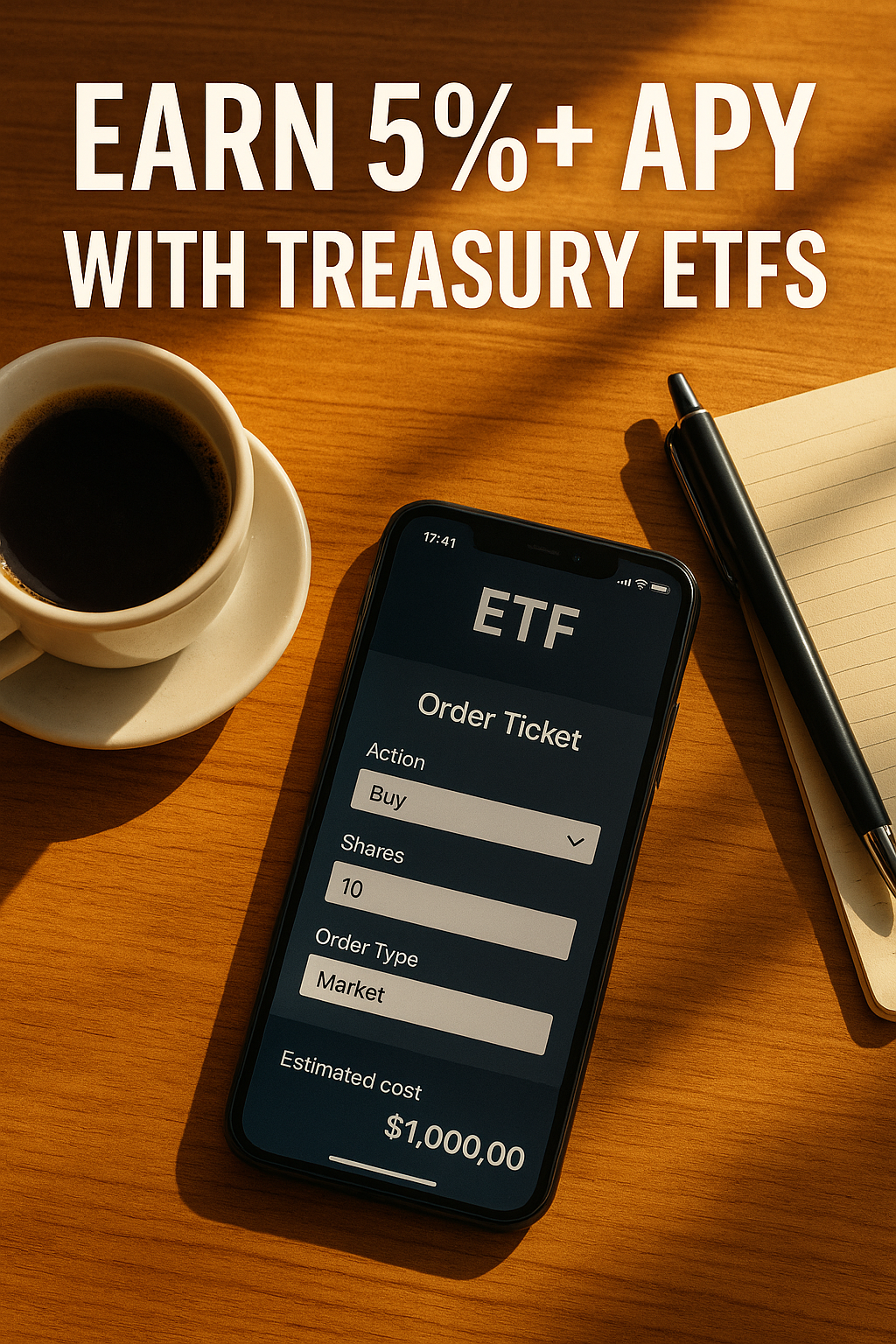Introduction
Have a spare hour this weekend and at least one hundred U.S. dollars languishing in a low-interest account? Treasury exchange-traded funds (ETFs) let everyday savers capture the same “risk-free” yield that banks enjoy on cash. As of May 2025, one-to-three-month Treasury bills pay about 5.2 % APY. A low-fee ETF that holds those bills passes almost the entire rate to you—no auction account, no paperwork.
Why Treasury ETFs beat savings accounts
Most online savings accounts still pay 2 %–3.5 % APY. The bank pockets the gap between that and the Treasury rate. Treasury ETFs close it. Each share represents dozens of short-term bills that roll over automatically, so your cash always enjoys the current auction yield. Two extra perks:
- State-tax break. Treasury interest is exempt from U.S. state and local income tax, shaving 0.3–0.7 percentage points off your headline rate.
- Daily liquidity. Sell any trading day and have settled cash within forty-eight hours.
Three tickers to consider
| Ticker | Fund name | Expense ratio | 30-day SEC yield* |
|---|---|---|---|
| SGOV | iShares 0-3 Month Treasury ETF | 0.07 % | 5.19 % |
| BIL | SPDR Bloomberg 1-3 Month T-Bill ETF | 0.14 % | 5.15 % |
| TFLO | iShares Treasury Floating Rate Bond ETF | 0.15 % | 5.18 % |
*Issuer data, 31 May 2025. Yields reset after every Treasury auction.
Quick pick: SGOV is the simplest, lowest-cost parking spot for idle cash.
The 30-minute weekend workflow
- Open or log in to a brokerage with commission-free ETFs (Fidelity, Schwab, Robinhood, Interactive Brokers).
- Transfer cash. ACH on Friday evening usually posts Monday; bank wires post the same day.
- Search the ticker (e.g., SGOV) and confirm the fund name matches.
- Place a market buy order for your desired amount. One share ≈ $100.
- Enable dividend reinvestment (DRIP) so monthly interest buys more shares automatically.
- Set a quarterly reminder to ensure the yield still mirrors the latest bill auction.
Expected earnings
Parking $10 000 in SGOV at 5.2 % yields roughly $520 a year, or about $43 every month. Living in a 6 % state-income-tax jurisdiction bumps your after-tax return to ~5.5 %. That beats the national average high-yield savings rate by more than two full percentage points, yet carries the same federal credit backing your cash.
Comparison with certificates of deposit
A 12-month CD from a major U.S. bank currently pays about 4 %. CDs lock your money until maturity and charge a three-month-interest penalty for early withdrawal. Treasury ETFs, by contrast, let you exit any trading day without penalty and usually catch each rate hike within weeks.
Live example
Emma, a freelance designer, had $7 500 sitting in a business checking account at 0.4 %. One Saturday she opened a free Fidelity account, transferred the money, and bought 75 shares of SGOV. The entire process—including ID verification—took 28 minutes. Her first monthly distribution, $32.38, arrived 34 days later. Emma now auto-sweeps every invoice payment received on Friday into SGOV by Sunday night. She spends less than five minutes per month on maintenance and sleeps better knowing her cash finally works as hard as she does.
Risks and quick answers
- Price movement – Each new bill auction nudges the share price by pennies, not dollars; volatility is minimal.
- Falling rates? – The yield resets lower at each rollover but will still track the Treasury curve.
- FDIC? – ETFs are securities, not bank deposits; safety comes from the underlying bills, not insurance.
- Taxes? – Interest is fully taxable at the federal level. Hold inside an IRA to defer.
Troubleshooting tip
If your broker adds a surprise commission or flashes a “low price” warning, verify you picked the exact ticker—not a leveraged look-alike. Legitimate short-bill ETFs never use leverage; look for fees below 0.20 % and assets above $1 billion.
Exit strategy
Need money for a down payment or emergency? Sell the shares during market hours and move the cash once it settles (T+1 or T+2). Capital gains or losses rarely exceed a few dollars because the price stays near $100 per share.
Key takeaways
- Safe yield, minimal effort – Treasury ETFs hand you government-backed interest at half the work of a savings-account comparison hunt.
- Time cost – Setup ≈ 30 minutes; maintenance ≈ 5 minutes each quarter.
- After-tax yield – 5 %–5.5 % as of May 2025—roughly double many savings accounts.
